
Joseph Germain Geefs or Jozef Germain Geefs (23 December 1808 – 9 October 1885) was a Belgian sculptor. Also his six brothers Guillaume Geefs, Aloys Geefs, Jean Geefs, Théodore Geefs, Charles Geefs and Alexandre Geefs were sculptors. [1]

Joseph Germain Geefs or Jozef Germain Geefs (23 December 1808 – 9 October 1885) was a Belgian sculptor. Also his six brothers Guillaume Geefs, Aloys Geefs, Jean Geefs, Théodore Geefs, Charles Geefs and Alexandre Geefs were sculptors. [1]
Joseph Geefs was born in Antwerp, where he studied at the Royal Academy of Fine Arts, going on to École des Beaux-Arts de Paris and winning the Prix de Rome in 1836. In 1841, he became a lecturer in sculpture and anatomy at the Academy in Antwerp (his pupils included Bart van Hove and Jef Lambeaux), rising to be its director in 1876. He was made an officer of the Order of Leopold in 1859 by King Leopold I.
Geefs married a daughter of the architect Lodewijk Roelandt and probably produced the portrait medallion on his gravestone. [2] Geefs died in Antwerp, [3] aged 76, and was buried in Berchem. [4]

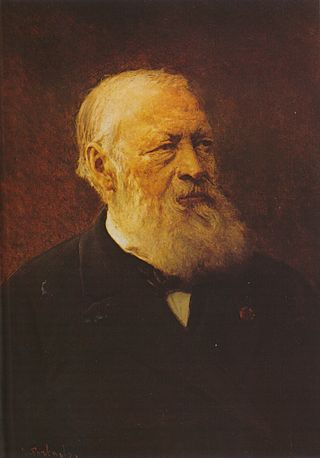
Henri (Hendrik) Conscience was a Belgian author. He is considered the pioneer of Dutch-language literature in Flanders, writing at a time when Belgium was dominated by the French language among the upper classes, in literature and government. Conscience fought as a Belgian revolutionary in 1830 and was a notable writer in the Romanticist style popular in the early 19th century. He is best known for his romantic nationalist novel, The Lion of Flanders (1838), inspired by the victory of a Flemish peasant militia over French knights at the 1302 Battle of the Golden Spurs during the Franco-Flemish War.

Henri Leys, Hendrik Leys or Jan August Hendrik, Baron Leys was a Belgian painter and printmaker. He was a leading representative of the historical or Romantic school in Belgian art and became a pioneer of the Realist movement in Belgium. His history and genre paintings and portraits earned him a European-wide reputation and his style was influential on artists in and outside Belgium.
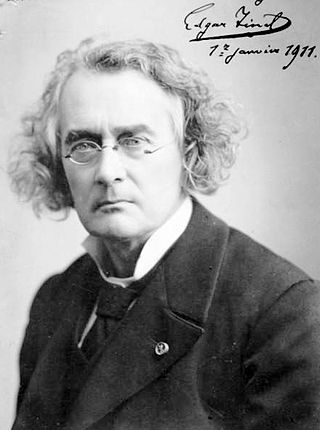
Edgar Pierre Joseph Tinel was a Belgian composer and pianist.

Emile Wauters was a Belgian painter. He was born in Brussels. Successively the pupil of Portaels and Jean-Léon Gérôme, he produced in 1868 The Battle of Hastings: the Finding of the body of Harold by Edith.

Guillaume Geefs, also Willem Geefs, was a Belgian sculptor. Although known primarily for his monumental works and public portraits of statesmen and nationalist figures, he also explored mythological subject matter, often with an erotic theme.
Jef Lambeaux or Josef Lambeaux was a Belgian sculptor. His best known work is Temple of Human Passions, a colossal marble bas-relief.
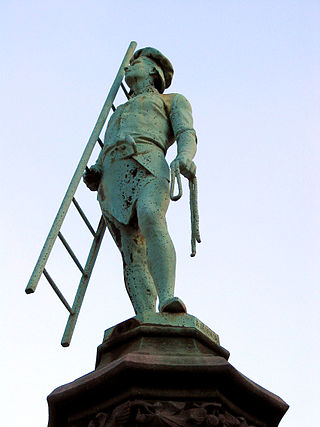
Xavier Mellery was a Belgian symbolist painter.

The Royal Museum of Fine Arts Antwerp is a museum in Antwerp, Belgium, founded in 1810, that houses a collection of paintings, sculptures and drawings from the fourteenth to the twentieth centuries. This collection is representative of the artistic production and the taste of art enthusiasts in Antwerp, Belgium and the Northern and Southern Netherlands since the 15th century.
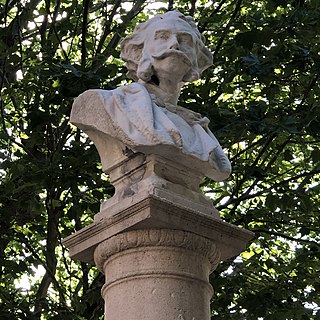
Karel Miry was a Belgian composer. He was one of the first Belgian composers to write operas to librettos in Dutch and is known as the composer of the music for De Vlaamse Leeuw, the national anthem of Flanders, for which Hippoliet van Peene wrote the lyrics.

Nicaise de Keyser was a Belgian painter of mainly history paintings and portraits who was one of the key figures in the Belgian Romantic-historical school of painting.
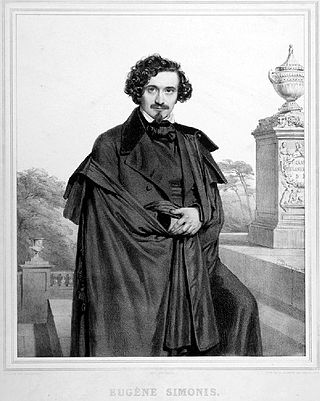
Louis-Eugène Simonis was a Belgian sculptor.
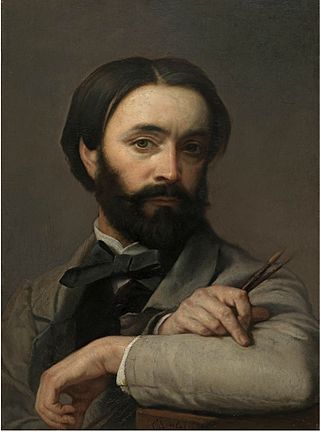
Charles Verlat or Karel Verlat was a Belgian painter, watercolorist, engraver (printmaker), art educator and director of the Antwerp Academy. He painted many subjects and was particularly known as an animalier and portrait painter. He also created Orientalist works, genre scenes, including a number of singeries, religious compositions and still lifes.

Baron Thomas Jules Vinçotte was a Belgian sculptor and medallist.
The Royal Academy of Science, Letters and Fine Arts of Belgium is the independent learned society of science and arts of the French Community of Belgium. One of Belgium's numerous academies, it is the French-speaking counterpart of the Royal Flemish Academy of Belgium for Science and the Arts. In 2001 both academies founded a joint association for the purpose of promoting science and arts on an international level: The Royal Academies for Science and the Arts of Belgium (RASAB). All three institutions are located in the same building, the Academy Palace in Brussels.

Joseph Stallaert was a Belgian painter and art educator. He is known for his scenes from antiquity executed in a Classicistic and Academic style going back on the French models of Louis David.

Joseph Lies or Joseph Henri Hubert Lies was a Belgian Romantic painter, draughtsman and engraver. He worked in a wide range of genres including history painting, landscapes, genre scenes and portraits. He enjoyed a European-wide reputation during his lifetime.

Josephus Laurentius Dyckmans or Jozef Laurent Dyckmans was a Belgian painter mainly of genre scenes and portraits whose painstakingly detailed pictures earned him the nickname 'The Belgian Gerard Dou'.

Jean Pierre François Lamorinière, Jan Pieter Frans Lamorinière or François Lamorinière was a Belgian landscape painter best known for his realistic depictions of landscapes in his home country. His work is situated between the previous generation of the Romantic landscape painters and the Realist landscape.
The following lists events that happened during 1885 in the Kingdom of Belgium.

Pieter Van Havermaet or Petrus Van Havermaet, known in his time as P. Van Havermaet was a Belgian draughtsman, painter and art educator. He is mainly known for his portraits and genre portraits. After first training in his native Sint-Niklaas he spent the rest of his career in Antwerp with intermittent periods of work in London where he made portraits of prominent individuals such as Benjamin Disraeli and Sir George Elliot.